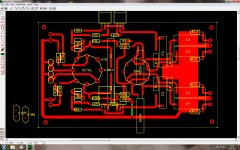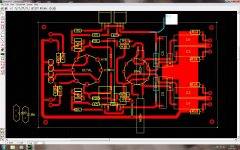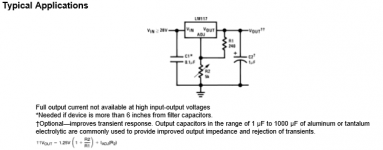reasonably close
Not ideal but should be sufficient. R6 and R7 is most important I think. DN2540 is prone to oscillate without proper GS. Tubes can sometimes do without. The relationship between IC1 (LM317, C104, Q2, Q1 drags my attention the most. Bad luck can make them oscillate together. You coud try change value or type on C104.
Where do you have B+ in on the PCB? LM317 sometimes needs a cap on the audio circuit side if you have cabling inbetween. I'm not sure it was Stuarts intention to split up the B+ and audio circuit after the zobel and going direct in on DN2540 without a cap on the recieving side. And be sure to twist the cabling good. The can be a good antenna for the 2540 to oscillate on.
Edit. Just spotted C5.
Edit. Just spotted C5.
Last edited:
B+ comes in at the junction of C5/R11. I omitted a PCB spot for the connection so it goes to the track at the top of C5, both C5 L and C5 R are then linked.
Attachments
Last edited:
Yes. Its drawn like that. IMO it makes it kind of interconnect dependent. I would have regs on board for a number of reasons and raw B+ in. Lets see what SY has to say when its morning in Illinois.
http://www.stereophile.com/content/burning-amps-slow-burn
Twisted cablings. I think I see a fairly big cap somewhere at the output. Might that be C104?
http://www.stereophile.com/content/burning-amps-slow-burn
Twisted cablings. I think I see a fairly big cap somewhere at the output. Might that be C104?
Last edited:
I've just ordered an Electro-Harmonix ECC83.
I hope that's a typo!😀
C5 is the local bypass.
I hope that's a typo!😀
C5 is the local bypass.
Quite correct, it should read ECC88.
Did you ever try to bypass the 6SN7 bias LEDs with say 1000uF cap for each pair to ground so to see if the white noise has anything to do with those? There are so many LED manufacturers out there and you never know how their parts react to highish constant current.
I used the CCIR-2K filter with average metering (a la Dolby) and the noise is around 400uV --using Electro Harmonix tubes. A "beater" 6SN7 was a little bit higher.
Katie -- I think that the problem may be unique to your "build".
Katie -- I think that the problem may be unique to your "build".
I used the CCIR-2K filter with average metering (a la Dolby) and the noise is around 400uV --using Electro Harmonix tubes. A "beater" 6SN7 was a little bit higher.
Katie -- I think that the problem may be unique to your "build".
I recently tested different tubes in luvdunhill's Impasse build. Here are the hum and noise measurements it got:
Electro-Harmonix 6SN7EH
right ch differential 2.0mV
left ch differential 1.1mV
Sylvania 6SN7GTB
left ch differential 2.1mV
right ch differential 1.8mV
CBS 6SN7GT
left ch differential 0.8mV
right ch differential 1.2mV
TungSol 6SN7
right ch differential 1.6mV
left ch differential 2.8mV
CBS JAN-CHY-5692 -- GREAT TUBE !!!!
left ch differential 0.4mV
right ch differential 0.4mV
So, tubes do make a difference.
Ihquam. I do wonder what this is about. Tubes dont make that kind of noice but they can of course pick it up from something. We have to figure out what differs the tube brands in this build. I take it the build had an input transformer. First question: what kind of noice was it, 100 Hz with overtones?
Measure the voltage drop across the 12.5 K resistor on each plate with the impasse input transformer shorted -- it should be 100V (8ma). If it's higher you've blown the depletion MOSFETs and the 6SN7 will run noisily.
It would be helpful if you could give us a sound-card FFT of what the output looks like with 140mV input you should see 2.8V out. If it's less, another sign that the current source is blown.
It would be helpful if you could give us a sound-card FFT of what the output looks like with 140mV input you should see 2.8V out. If it's less, another sign that the current source is blown.
- Home
- Amplifiers
- Pass Labs
- ImPasse Preamplifier


